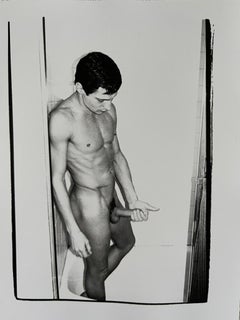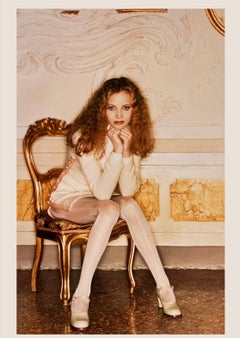Irving Penn On Sale
1940s Modern Photography
Silver Gelatin, Photographic Paper
People Also Browsed
1970s American Modern Nude Photography
Silver Gelatin
1980s Pop Art Color Photography
C Print
1970s Pop Art Black and White Photography
Silver Gelatin
Vintage 1970s European Mid-Century Modern Photography
Paper
20th Century Black and White Photography
Silver Gelatin
1940s Nude Photography
Silver Gelatin
2010s Contemporary Still-life Photography
Digital Pigment
1940s Modern Color Photography
Dye Transfer
1940s Modern Color Photography
Dye Transfer
1970s Contemporary Photography
Platinum
Irving Penn for sale on 1stDibs
With a career in magazines that spanned the mid-20th century heyday of print journalism and lasted through the first decade of the 21st, Irving Penn was the preeminent photographer for six decades at Vogue, where he worked right up until his death, in 2009, at age 92.
Penn’s refined and dynamic photography of models, celebrities and products like Clinique and Jell-O pudding, all shot in compositions of stunning equipoise in the cool remove of his minimal studio setups, were designed to stop traffic and cut through the clutter of magazine pages.
Penn flourished under the mentorship of two legendary art directors: Harper’s Bazaar‘s Alexey Brodovitch and Vogue‘s Alexander Liberman, both Russian émigrés like Penn’s father. Brodovitch introduced Penn to Surrealism and avant-garde photography as his teacher at the Pennsylvania Museum and School of Industrial Art and hired him as his assistant at Harper’s Bazaar during the summers of 1937 and ’38. Penn bought his first camera after graduating that year. He met Liberman in 1941, passing off to the recent New York transplant his freelance art director job at Saks Fifth Avenue. Liberman returned the favor by hiring Penn at Vogue in 1943 to sketch cover concepts, later encouraging him to shoot his unconventional juxtapositions of accessories and household items himself.
Assigned to photograph some portraits in the mid-1940s, Penn took a cue from the stage-set windows at Saks. He angled two studio flats in his studio and placed his subjects, including Truman Capote, Jerome Robbins and Salvador Dalí, in the resulting tight corner, literally and psychologically. Spencer Tracy leans jauntily against the walls in his portrait, while Georgia O'Keeffe simmers straight-armed in her confinement.
Penn didn’t work well with the distractions of the outside world. In 1950, when he was instructed by Liberman to buy an evening jacket and shoot the couture shows in Paris, he managed the assignment by having the dresses brought to him. He rented a top-floor studio with great light but no electricity and photographed models, including Lisa Fonssagrives (whom he married shortly after), against a mottled gray theater curtain that he continued to use for the rest of his career. Between deliveries from Dior and Balenciaga, he began his personal project “Small Trades,” in which he had local Parisians — a knife grinder, a mailman, a cucumber seller — pose for him with tools of their trade against the same backdrop. (He extended the series in London and New York.)
While Penn made bold, reductive still lifes for advertising campaigns throughout his career, in 1972 he applied his sculptural understanding of form to the unlikeliest of subjects: cigarette butts he gathered from the streets. The Museum of Modern Art showed Penn’s cigarette butts in 1975, and the Metropolitan Museum of Art exhibited another series of material salvaged from the street in 1977. At this time, Penn also began revisiting his earlier photographs, reprinting them at larger scale and with the more painterly quality achieved with the platinum-palladium process. In his lush, oversized platinum-palladium prints, he elevates the lowly castoffs to heroic objects worthy of archaeological scrutiny.
Find vintage Irving Penn photography on 1stDibs.
A Close Look at Modern Art
The first decades of the 20th century were a period of artistic upheaval, with modern art movements including Cubism, Surrealism, Futurism and Dadaism questioning centuries of traditional views of what art should be. Using abstraction, experimental forms and interdisciplinary techniques, painters, sculptors, photographers, printmakers and performance artists all pushed the boundaries of creative expression.
Major exhibitions, like the 1913 Armory Show in New York City — also known as the “International Exhibition of Modern Art,” in which works like the radically angular Nude Descending a Staircase by Marcel Duchamp caused a sensation — challenged the perspective of viewers and critics and heralded the arrival of modern art in the United States. But the movement’s revolutionary spirit took shape in the 19th century.
The Industrial Revolution, which ushered in new technology and cultural conditions across the world, transformed art from something mostly commissioned by the wealthy or the church to work that responded to personal experiences. The Impressionist style emerged in 1860s France with artists like Claude Monet, Paul Cézanne and Edgar Degas quickly painting works that captured moments of light and urban life. Around the same time in England, the Pre-Raphaelites, like Edward Burne-Jones and Dante Gabriel Rossetti, borrowed from late medieval and early Renaissance art to imbue their art with symbolism and modern ideas of beauty.
Emerging from this disruption of the artistic status quo, modern art went further in rejecting conventions and embracing innovation. The bold legacy of leading modern artists Georges Braque, Pablo Picasso, Frida Kahlo, Salvador Dalí, Henri Matisse, Joan Miró, Marc Chagall, Piet Mondrian and many others continues to inform visual culture today.
Find a collection of modern paintings, sculptures, prints and other fine art on 1stDibs.
Finding the Right portrait-photography for You
Portrait photography can be a powerful part of your wall decor. Find a provocative and compelling portrait that speaks to you and you might find that the photograph will speak to your guests too.
Prior to the development of photography, which eventually replaced portrait paintings as a quicker and more efficient way of capturing a person’s essence, the subject of a portrait had to sit for hours until the painter had finished. In 1839, chemist and Philadelphia-based photographer Robert Cornelius didn’t have to wait very long for his portrait. In a matter of minutes, he captured what many believe to be the first portrait photograph. This shot was also the first self-portrait (or what we now call a “selfie”), and fine photography quickly became an art form.
Landscape photography, nude photography and portrait photography are very popular in today's modern interiors. A portrait can reveal a lot about the person in it. It can also add a narrative touch to your decor. You’ll often find that photographs of loved ones work well as decorative touches. A portrait of a family member or dear friend can help turn a house into a home, warming any space by evoking fond memories.
While family portraits can stir emotion, portraits of celebrities and important historical figures can also add a rich dynamic to your space. Portraits of famous musicians or intriguing actors hung in your dining room or home bar shot by Gered Mankowitz or Annie Leibovitz might inspire deep conversation over meals or drinks. Douglas Kirkland is also famous for his celebrity portraits. His photojournalism made him much sought after by Hollywood studios to document the filming of movies. In Kirkland’s powerful depiction of Hollywood stars, he excellently captures the glamour of their lives.
Other artists like Elliott Erwitt stand out by turning portraiture into a playful art form. Before graduating from high school in Hollywood, Erwitt had already begun to teach himself to take pictures, inspired by the work of Henri Cartier-Bresson. In image after image, Erwitt captured what photographers call “the moment” with rapier wit and penetrating humanity.
Portrait photography can be incredibly expressive, setting the tone and mood for a room. And there are different ways of incorporating portrait photography into your interior decor. If you’re thinking about adding color photography to a bedroom or living room, the colors of the portraits can become part of the room’s palette, while portraits shot in black and white won’t disrupt an existing color scheme.
On 1stDibs, find a vast selection of portrait photography from different eras, including 1950s portraits, 1960s portrait photography and more.


